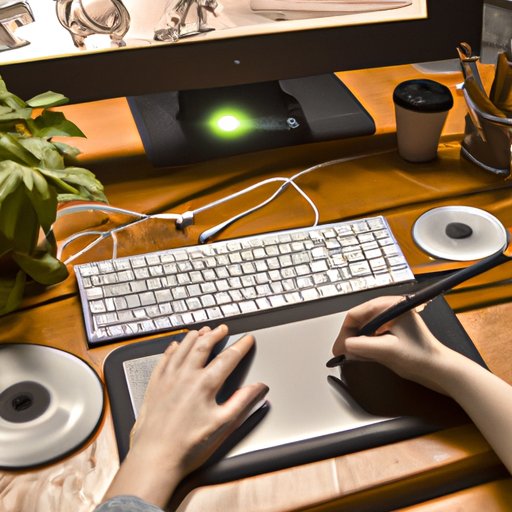Introduction
A graphic artist is an individual who uses art and design to create visual solutions to communication problems. This can include anything from creating logos, illustrations, and advertisements to designing websites, magazines, and books. Graphic artists are highly sought after in today’s digital world, where visuals are increasingly being used to convey messages and engage audiences.
A Beginner’s Guide to Becoming a Graphic Artist
If you’re interested in becoming a graphic artist, there are several steps you should take. First, you need to have the right skills and qualifications. Most graphic designers have a degree or certificate in graphic design, but it’s not always necessary. You should also have a good eye for detail, an understanding of color theory, and strong computer skills.
Once you have the basic skills and qualifications, it’s time to find training and education opportunities. There are many online courses and tutorials available, as well as traditional programs at universities and colleges. Additionally, internships and apprenticeships are another great way to gain experience and build your portfolio.
Finally, you should work on building your portfolio. This is a collection of your best work that you can show potential employers. It should include examples of logo designs, illustrations, website designs, and other projects you’ve completed. Having a portfolio will help you stand out from other applicants and make it easier to find work.

The Creative Process Behind Graphic Design
Once you have the necessary skills and qualifications, it’s time to start working on projects. The first step is to understand your client’s needs. This involves communicating with them to determine their goals and objectives for the project. Once you have a clear understanding of what they want to achieve, you can begin brainstorming ideas.
The next step is to choose the right tools for the job. This includes selecting the appropriate software, hardware, and materials to create the desired result. For example, if you’re designing a logo, you might use Adobe Illustrator or Photoshop, while if you’re creating a website, you might use HTML and CSS.
Once you’ve chosen the right tools, it’s time to start creating. This involves brainstorming ideas, sketching concepts, and refining the design until it meets the client’s expectations. The goal is to create a visually appealing design that conveys the message in an effective way.

How to Choose the Right Graphic Artist for Your Project
When choosing a graphic artist for your project, there are several things to consider. First, look at the artist’s style. Do their previous works fit with the aesthetic you’re trying to achieve? If not, then it’s probably best to move on to someone else.
Next, check out their portfolio. This will give you an idea of their skill level and the types of projects they’ve worked on. Finally, discuss your expectations with them. This will help ensure that you’re both on the same page and that the final product meets your needs.
An Interview with a Professional Graphic Artist
We recently had the opportunity to speak with professional graphic artist, Martha Smith. Here’s what she had to say about her career path and advice for aspiring graphic artists.
Martha chose graphic arts as a career because she wanted to make a positive impact on the world. She loves the challenge of creating something unique and meaningful, and she enjoys collaborating with clients to bring their vision to life. Her favorite projects are ones that involve a lot of creativity and problem-solving.
In terms of advice for aspiring graphic artists, Martha recommends starting small and gaining experience. She also suggests learning from your mistakes and never giving up. Finally, she advises staying up-to-date on the latest trends and technologies in the field.

Trends in Graphic Arts: What You Need to Know
As technology advances, so does the field of graphic design. Some of the most popular software and equipment for graphic artists includes Adobe Creative Suite, Wacom tablets, and 3D printers. Additionally, new and emerging techniques such as animation, motion graphics, and virtual reality are becoming increasingly popular.
Finally, there have been some recent developments in digital art. For example, AI-generated artwork is becoming more common, and digital painting apps are making it easier for artists to create stunning works of art.
Conclusion
Graphic artists play an important role in modern society. They use their creative skills and technical knowledge to create visual solutions to communication problems. To become a successful graphic artist, you need to have the right skills and qualifications, find training and education opportunities, and work on your portfolio. Additionally, understanding the creative process behind graphic design and staying up-to-date on the latest trends and technologies is essential. Finally, when hiring a graphic artist, make sure to consider their style, check out their previous work, and discuss your expectations.
(Note: Is this article not meeting your expectations? Do you have knowledge or insights to share? Unlock new opportunities and expand your reach by joining our authors team. Click Registration to join us and share your expertise with our readers.)
